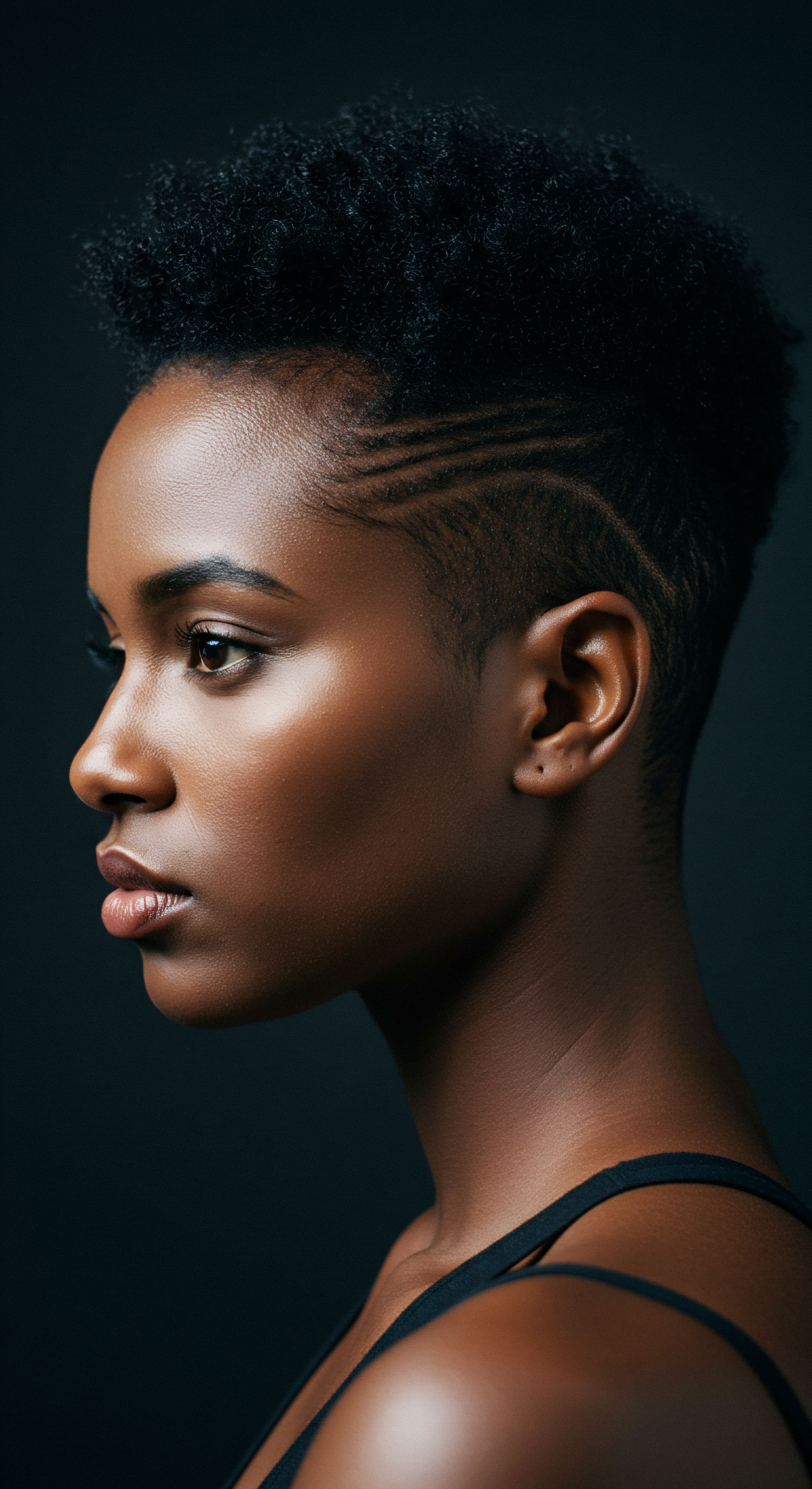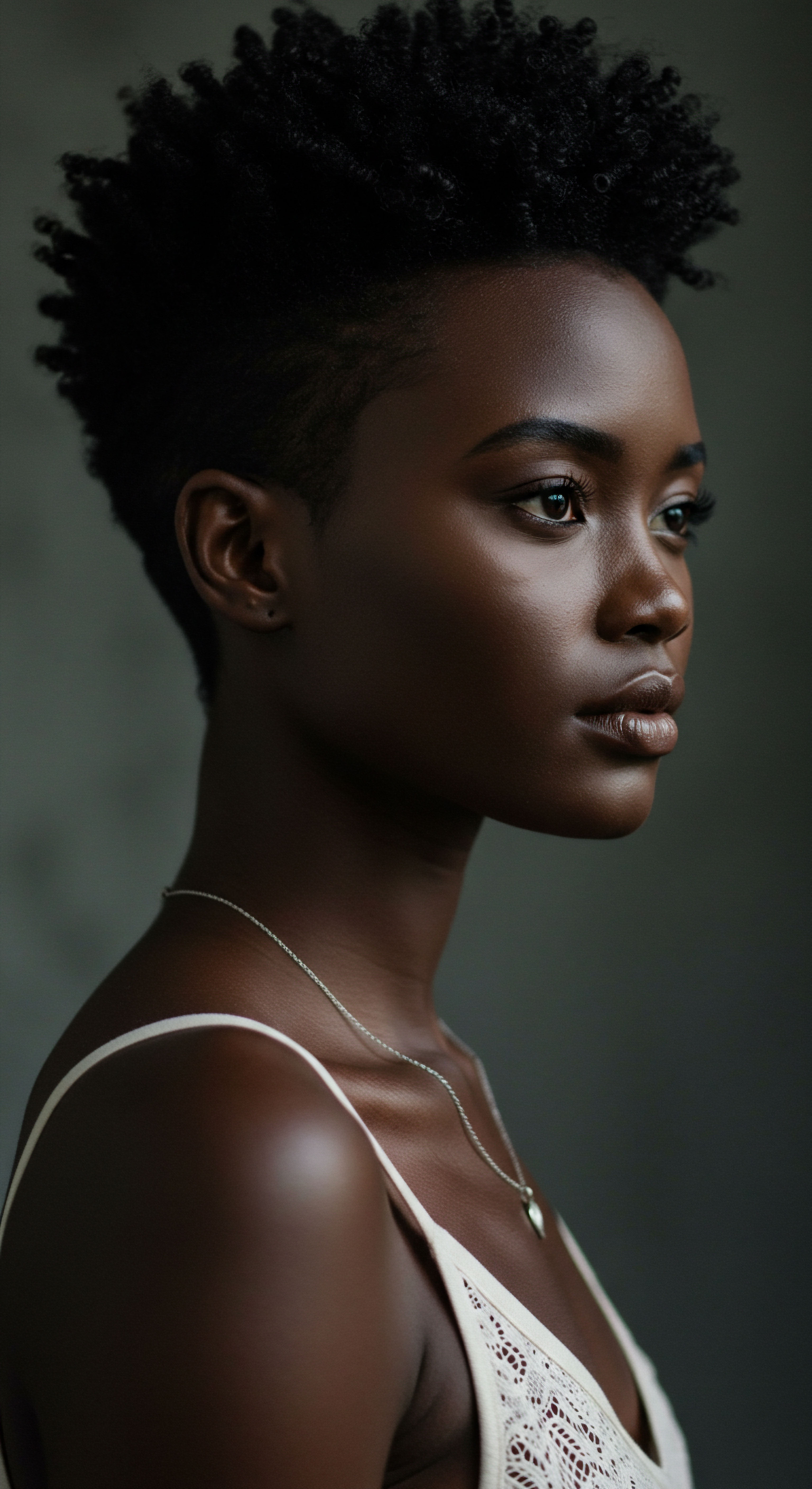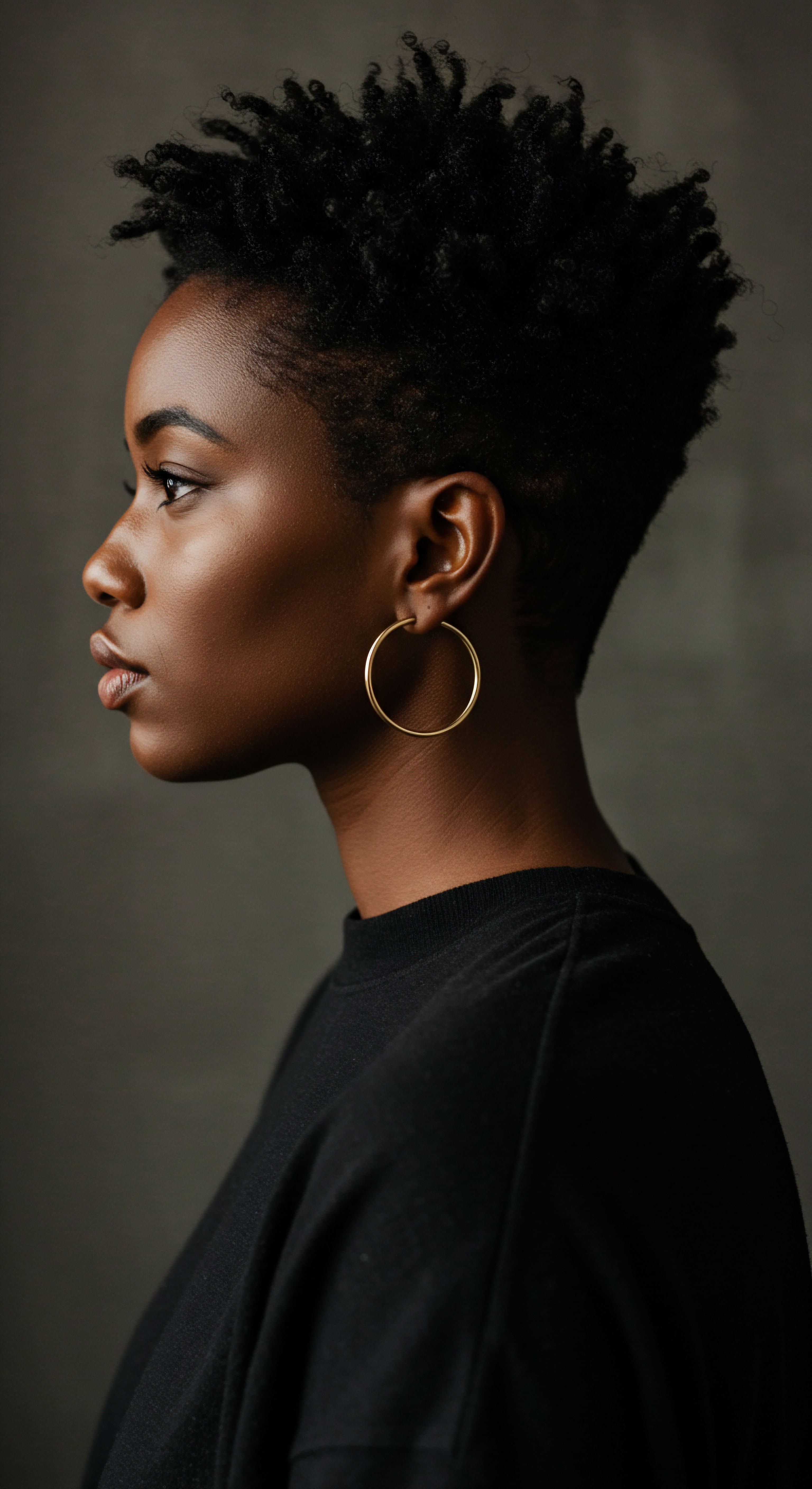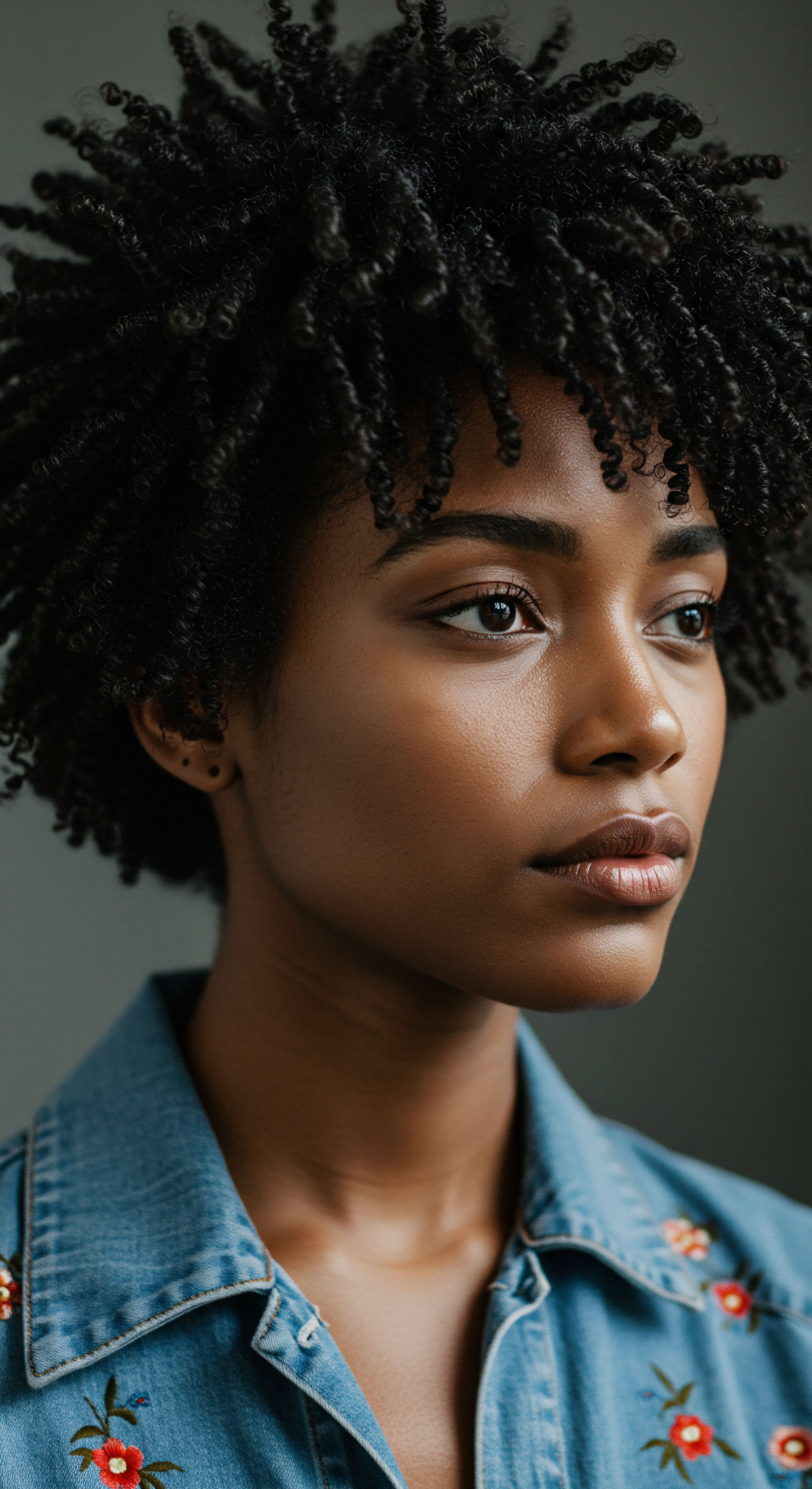
Roots
The quiet hours of the night hold a profound, often overlooked, connection to the vitality of our hair. Many consider hair care a daytime pursuit, a ritual of cleansing, conditioning, and styling. Yet, as the world settles into slumber, a hidden symphony of cellular repair and hormonal regulation unfolds within us, a delicate dance that profoundly shapes the health and appearance of our strands. To truly understand how our nightly rest affects hair, we must first look beneath the surface, exploring the very foundations of hair biology and the intricate rhythms that govern its existence.
Hair, in its remarkable resilience and diversity, is far more than mere adornment. It is a living extension of our bodies, deeply intertwined with our physiological processes. The scalp, a highly vascular environment, serves as the nurturing ground for hair follicles, those tiny organs responsible for hair production.
Each follicle operates on its own internal clock, following a distinct growth cycle that sees strands emerge, mature, rest, and eventually shed to make way for new beginnings. This cyclical nature is a testament to the body’s continuous renewal, a process significantly influenced by the quality and consistency of our rest.
The silent hours of nightly rest orchestrate a symphony of biological processes critical for hair vitality.

Hair Follicle Cycles and Circadian Rhythms
The growth of hair is not a constant, uninterrupted flow. Instead, it follows a precise, three-phase cycle:
- Anagen ❉ The active growth phase, where hair follicles produce new hair. This period can last for several years.
- Catagen ❉ A brief transitional phase, where hair growth slows, and the follicle begins to shrink.
- Telogen ❉ The resting phase, during which hair stops growing and eventually sheds, making room for fresh growth.
These cycles are intricately linked to the body’s internal biological clock, known as the circadian rhythm. This 24-hour cycle governs various physiological functions, including sleep-wake patterns, hormone secretion, and cellular repair. Hair follicles themselves exhibit circadian changes, expressing core clock genes that modulate the hair follicle cycle.
A consistent, healthy sleep pattern supports the natural progression of these phases, allowing hair follicles to operate optimally. When this rhythm is disrupted, the delicate balance can falter, potentially shortening the anagen phase and pushing follicles into the resting phase prematurely.

Hormonal Balance and Hair Vitality
The nightly period of rest is a crucial time for hormonal regulation, with direct implications for hair health. Two key hormones, cortisol and melatonin, play particularly significant roles.
Cortisol, often referred to as the stress hormone, is produced by the adrenal glands. While it has essential functions in regulating metabolism and blood pressure, prolonged elevated levels can be detrimental. Sleep deprivation causes the body to produce more cortisol, especially during the day, potentially in an effort to stimulate alertness.
High cortisol levels have been associated with various types of hair loss, including telogen effluvium, a condition characterized by excessive shedding where hair follicles are forced into an early resting phase. Chronic stress, often linked to insufficient sleep, can also contribute to autoimmune conditions like alopecia areata.
Melatonin, on the other hand, is primarily known for regulating sleep-wake cycles, with its production peaking during darkness. Beyond its sleep-inducing properties, melatonin also appears to have a role within the hair follicle itself. Research indicates that melatonin possesses antioxidant properties and may stimulate cell growth, with some studies suggesting it could directly promote hair growth by prolonging the anagen phase.
Initial findings even suggest that topical melatonin treatment can positively affect androgenetic hair loss, particularly in women. When the night-time rhythm is disrupted, and sleep is insufficient, the synthesis of growth hormones, including those that manage hair growth, can be disturbed, leading to hair that grows less effectively and whose vital cycle is disrupted.

Ritual
As we move beyond the foundational understanding of how our inner workings relate to hair health, our gaze shifts to the practices that honor and support this connection. The nightly ritual, far from being a mere routine, becomes a profound act of care, a quiet conversation with our strands as they prepare for their essential restorative work. It is here, in the gentle application of wisdom, that we truly begin to safeguard our hair’s resilience. The choices we make as dusk settles, from the tools we employ to the environment we cultivate, hold sway over the very texture and strength that greet us with the morning light.
The delicate nature of textured hair, with its unique curl patterns and propensity for dryness, renders nighttime protection especially important. Friction, moisture loss, and mechanical stress are silent adversaries that can compromise even the most diligently cared-for tresses. Understanding how to mitigate these challenges transforms sleep from a period of potential damage into a profound opportunity for hair rejuvenation.
Conscious nightly hair practices are a profound expression of care, safeguarding strands during essential restorative hours.

What Nightly Practices Preserve Hair Moisture?
Moisture retention stands as a cornerstone of healthy textured hair. During sleep, hair can lose vital hydration to absorbent fabrics, leading to dryness, frizz, and increased susceptibility to breakage. Conscious choices can counteract this effect.
- Hydrating Leave-Ins ❉ Applying a light, water-based leave-in conditioner or a botanical oil before bed can create a protective barrier, sealing moisture within the hair shaft. This allows the hair to remain supple and less prone to dehydration throughout the night.
- Protective Styles ❉ Gathering hair into loose, protective styles minimizes tangling and friction against bedding. Options such as a pineapple (a high, loose ponytail at the crown), loose braids, or twists can keep strands contained and prevent them from rubbing against each other or abrasive surfaces.
- Understanding Hair Porosity ❉ Knowing your hair’s porosity, its ability to absorb and retain moisture, guides product selection. Low porosity hair benefits from lighter, more penetrating oils, while high porosity hair may require heavier creams to seal the cuticle.
Consider the simple yet profound difference a thoughtful application of moisture can make. Just as a plant thrives with consistent hydration, so too do our hair strands benefit from a continuous, gentle supply of water and emollients, especially during the long hours of rest.

Does Pillowcase Material Influence Hair Breakage?
The surface upon which our hair rests for hours each night holds significant sway over its integrity. Traditional cotton pillowcases, while commonplace, can be surprisingly harsh on hair, particularly textured hair. The coarse fibers create friction, which can lead to tangles, frizz, and mechanical breakage. Cotton also absorbs moisture, drawing essential hydration away from the hair and scalp.
In contrast, smoother materials offer a gentler embrace.
| Material Cotton |
| Hair Impact Increased frizz, tangles, breakage, dryness |
| Moisture Retention Low (absorbent) |
| Friction Reduction Low (rough texture) |
| Material Silk |
| Hair Impact Reduced frizz, tangles, breakage, dryness |
| Moisture Retention High (non-absorbent) |
| Friction Reduction High (smooth surface) |
| Material Satin |
| Hair Impact Reduced frizz, tangles, breakage, dryness |
| Moisture Retention Medium (less absorbent than cotton) |
| Friction Reduction High (smooth surface) |
| Material Silk and satin pillowcases offer superior protection for hair during sleep compared to cotton. |
A study published in the Journal of Cosmetic Dermatology indicated that the smooth surface of a silk pillowcase can reduce hair friction by up to 43%. This reduction in friction translates directly to less breakage and frizz, allowing hair to glide effortlessly rather than snagging. For individuals with textured hair, this difference is palpable, often resulting in smoother, more defined curls and coils upon waking. The choice of pillowcase material becomes a silent guardian, a subtle yet powerful element in the nightly care ritual.

Why Are Bonnets Essential for Nighttime Hair Protection?
Beyond pillowcases, the humble bonnet holds a cherished place in the nighttime regimen for textured hair. A bonnet creates a protective cocoon, shielding hair from the environment and preventing direct contact with bedding. This not only preserves hairstyles, extending the life of washes and sets, but also significantly reduces friction and moisture loss.
The bonnet’s purpose extends to maintaining the integrity of delicate hair patterns. For those with coils, curls, or waves, a bonnet helps to prevent the flattening and disruption that can occur during sleep, ensuring that definition remains intact. It serves as a gentle reminder that even in rest, we can actively participate in the wellbeing of our hair.

Relay
Our understanding of nightly rest and hair health deepens as we consider the intricate interplay of biological systems and external influences. The relationship extends far beyond the visible strands, reaching into the very core of cellular function, hormonal communication, and even the subtle rhythms of our existence. This exploration requires a shift from mere observation to a more profound inquiry, recognizing hair not as an isolated entity, but as a sensitive barometer of our internal landscape and external environment. The wisdom of our ancestors, who understood the significance of restorative practices, finds validation in contemporary scientific discovery, revealing layers of connection previously unseen.
The complexity of this interaction means that the impact of nightly rest is rarely a singular event. Rather, it is a cumulative effect, a dialogue between our sleep patterns and the body’s capacity for repair and regeneration. This nuanced perspective invites us to consider not just the quantity of sleep, but its quality, its alignment with our natural rhythms, and the myriad ways it influences the biological processes that underpin hair vitality.
The profound connection between nightly rest and hair health extends beyond simple observation, reflecting intricate biological and environmental interplay.

How Does Sleep Quality Affect Hair Follicle Regeneration?
The regenerative capacity of hair follicles is profoundly influenced by sleep quality. During deep, non-REM sleep, the body enters a critical phase of repair and growth. This period witnesses an increase in cell turnover, tissue repair, and the elevation of key hormone levels, including melatonin and growth hormone.
These elements collectively support the anagen, or active growth phase, of the hair cycle. Disrupted or poor sleep can shorten this crucial phase, potentially contributing to slower growth or increased shedding over time.
A significant area of research explores the role of Stem Cells in hair growth. Hair follicle stem cells, residing within the follicle, are responsible for regenerating hair throughout life. These stem cells are highly dependent on the body’s internal clocks. A 2019 study in Cell Reports highlighted how disruptions to circadian rhythms, such as those experienced by shift workers, led to decreased stem cell activity within hair follicles.
Chronic disruption can reduce the regenerative capacity of these cells over time, resulting in thinner, weaker hair. This underscores that the rhythm of rest is not merely about feeling refreshed; it is about enabling the fundamental cellular machinery that keeps our hair thriving.

What is the Connection Between Stress Hormones and Hair Loss?
The interplay between sleep and stress hormones, particularly cortisol, represents a compelling aspect of hair health. Sleep deprivation is a recognized physiological stressor, triggering an increase in cortisol levels. While cortisol is a vital hormone, its chronic elevation can create a cascade of detrimental effects on hair.
High cortisol levels are linked to several types of hair loss:
- Telogen Effluvium ❉ This common condition involves stress-induced shedding, where hair follicles are prematurely pushed into the resting (telogen) phase. Elevated cortisol can delay the anagen (growth) phase and prolong the telogen phase, resulting in less hair growth and increased shedding.
- Androgenetic Alopecia ❉ While primarily genetic, this condition may be worsened by stress. A 2020 survey found a link between poor sleep quality and more severe female pattern hair loss, although other factors were also present.
- Alopecia Areata ❉ This autoimmune disorder, where the immune system mistakenly attacks hair follicles, can be triggered or exacerbated by chronic stress. A Korean study from 2002 to 2013 found that patients with a sleep disorder faced a significantly higher risk of alopecia areata.
The mechanism involves cortisol’s impact on the dermal papilla, a cluster of cells beneath the hair follicle. Research indicates that cortisol can prevent the dermal papilla from secreting GAS6, a molecule that activates hair follicle stem cells. This means that the sustained presence of stress hormones can directly inhibit the signals necessary for hair regrowth. Furthermore, elevated cortisol can decrease the production of collagen and elastin, proteins that support the health of hair follicles, leading to weaker and thinner strands.
Consider a compelling real-world data point that illustrates this connection:
A 2022 study of 102 adults, half with alopecia areata and half without, suggested a complex link between alopecia areata and poor sleep. Researchers noted that insufficient sleep can trigger autoimmune disorders, and alopecia areata often accompanies other autoimmune conditions.
This research highlights that the link between sleep deprivation and hair loss is often indirect, mediated by the body’s stress response and its impact on the immune system and hormonal balance. Improving sleep can lower cortisol and help reset the hair cycle, allowing follicles a chance to grow uninterrupted.

How Do Cultural Practices Inform Nighttime Hair Care?
Across diverse cultures, the evening hours have long been a time for rituals of preparation and preservation, particularly concerning hair. These practices, passed down through generations, often embody an intuitive understanding of hair’s needs for protection and nourishment during rest.
For many with textured hair, particularly within Black and mixed-race communities, the concept of nightly hair protection is deeply rooted in heritage. The use of head coverings, such as bonnets, wraps, and scarves, is not merely a modern trend but a continuation of practices designed to shield delicate strands from environmental aggressors and preserve intricate styles. These traditions predate scientific explanations of friction and moisture loss, yet they align perfectly with contemporary understanding of hair biology.
In some traditions, nighttime hair care extended to specific oils and preparations applied before bed, believed to nourish the scalp and promote healthy growth. While the scientific language may have been absent, the wisdom of these practices speaks to a deep connection with the body’s rhythms and the recognition of rest as a period of restoration. These cultural customs underscore a universal truth ❉ the deliberate act of preparing for rest, both for the body and its hair, is a powerful investment in wellbeing. The relay of this knowledge, from elder to youth, from tradition to modern science, continues to shape our approach to hair health.

Reflection
The quiet hours of nightly rest, often perceived as a mere cessation of activity, reveal themselves as a vibrant period of profound biological work, deeply shaping the vitality of our hair. From the intricate dance of circadian rhythms within each follicle to the delicate balance of hormones that govern growth and shedding, the quality of our sleep is a silent, yet powerful, determinant of our hair’s health. The friction of an ordinary pillowcase, the subtle shift in hormonal messengers, the cellular regeneration occurring in the stillness of the night – each element contributes to a complex narrative of care and resilience. As we awaken to the dawn, our hair, in its texture and strength, carries the story of the rest it received, a testament to the interconnectedness of our inner world and our outer expression.

References
- Cabos, Jean-François. “Hair and sleep ❉ the importance of the night for hair health.” Centre Clauderer, 2025.
- Dr Ali, FRCP (Edinburgh), FRCP (London), MBBS, MRCS, LRCP, DCH, DRCOG, MRCGP. “Sleep and Hair Growth – What’s the Connection?” HHC Clinics.
- Hair Doctors. “Can Lack of Sleep Make You Lose Hair? Uncovering the Connection.” Hair Doctors, 2025.
- Clinikally. “Impact of Sleep Deprivation on Hair Health.” Clinikally, 2024.
- HairFree & HairGrow. “Sleep and Hair Loss. Relationship Explained.” HairFree & HairGrow, 2023.
- Treatment Rooms London. “Can A Lack of Sleep Cause Hair Loss?” Treatment Rooms London, 2024.
- Wimpole Clinic. “Can Lack of Sleep Cause Hair Loss?” Wimpole Clinic.
- DiStefano Hair Restoration Center. “Does Sleep Affect Hair Health?” DiStefano Hair Restoration Center, 2025.
- Limmer Hair Transplant Center. “Can Lack of Sleep Cause Hair Loss?” Limmer Hair Transplant Center, 2025.
- MONPURE. “Why Sleep Is So Important For Your Scalp.” MONPURE, 2020.
- Dtex Homes. “Which Pillowcase Is Better for Your Hair?” Dtex Homes, 2025.
- Sivamani, Raja. “Circadian Rhythm and the Skin ❉ A Review of the Literature.” Journal of Clinical and Aesthetic Dermatology, 2019.
- Wong, Stephanie and Sivamani, Raja. “How Does the Circadian Rhythm Affect Hair Growth?” LearnSkin, 2017.
- The Hairy Pill. “Does Lack of Sleep Cause Hair Loss?” The Hairy Pill.
- Good Health by Hims. “Does Lack of Sleep Cause Hair Loss?” Good Health by Hims, 2024.
- L’Oréal Paris. “How Does Sleep Affect Hair Health & Growth?” L’Oréal Paris, 2022.
- Dr Serkan Aygin Clinic. “Do Your Sleeping Habits Affect Your Hair Loss?” Dr Serkan Aygin Clinic, 2022.
- Janssens, J.P. et al. “Hair Cortisol Concentration as a Biomarker of Sleep Quality and Related Disorders.” PMC, 2020.
- Zheng, J. et al. “Hair Follicles as a Critical Model for Monitoring the Circadian Clock.” PMC – PubMed Central, 2023.
- Hair Loss. “I stopped using cotton pillowcases and reduced hair breakage by 43% (what my hairstylist noticed after 2 weeks).” Hair Loss, 2025.
- Rest. “Ditch Cotton Pillowcases | Best Pillow Cases for Better Skin and Hair.” Rest.
- Nagasaka, Y. et al. “Hair test reveals plasticity of human chronotype.” bioRxiv, 2025.
- Bongiorno, Peter. “Stress, Immunity, and Hair Health.” Natural Medicine Journal, 2021.
- National Institutes of Health (NIH). “How stress causes hair loss.” NIH, 2021.
- PNWS-AWWA. “The effect of sleep quality on hair regrowth.” PNWS-AWWA, 2025.
- Healthline. “Cortisol and Sleep ❉ Can It Cause Insomnia? What Else?” Healthline, 2020.
- scooms. “Are silk pillowcases good for hair?” scooms, 2024.
- SHEEX.com. “Best Pillowcase Materials for Healthy Hair.” SHEEX.com, 2021.
- The Institute for Functional Medicine. “The Impact of Cortisol on Hair Loss and Skin Conditions ❉ What Health Practitioners Need to Know.” The Institute for Functional Medicine.
- HCPLive. “Hair, Scalp Health Linked to Perceived Stress and Sleep Quality.” HCPLive, 2025.
- Oxford Academic. “Newborn Hair Cortisol and Sleep Health in Infancy.” Oxford Academic, 2023.
- Li, L. et al. “Melatonin’s Role in Hair Follicle Growth and Development ❉ A Cashmere Goat Perspective.”